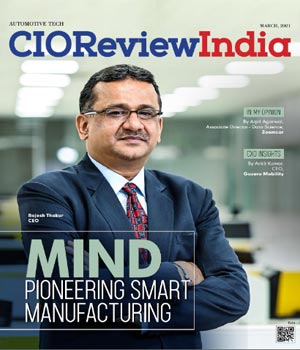
Connecting Big Data to Business Value
Jaydeep Deshpande, Regional Marketing Manager, Qlik
 Translating Big Data into Valuable Insights
Translating Big Data into Valuable Insights
Big Data is a misnomer, a kind of jargon which we use to familiarize ourselves with the vast amounts of data that we have access to today whether it is structured, unstructured, or semi-structured data that is in the form of excel sheets, RDBMS systems, ERP systems, geospatial data, mapping data, email, images, videos and so on. There is objectively no such thing as big data or small data. The classification is relative, cyclical, dependent on the solutions and technologies that we have available to process it. Yesterday’s big data is small data today, and today’s big data will be small data a couple of years down the line.
The size not withstanding, what is most essential is how we use the available data. Processing vast amounts of information to gather intelligence, provide insights, identify trends, and make data-driven fact-based decisions – that is what big data analytics does and the reason why such services are gaining in popularity across the world.
Managing and analyzing such vast amounts of data effectively, however, is often beyond the capabilities of many organizations. This is where Qlik comes in. Big data, for us, is an opportunity to leverage state-of-the-art technology to deliver fully-integrated, simple, and intuitive visual analytics and insights.
Challenges Encountered Delivering Big Data Projects
One of the biggest challenges faced while executing big data projects is getting the data to the hands of business users in a way that benefits them immediately. The problem becomes particularly more pronounced when the enterprise does not have data scientists or enough experience with complex IT systems required for big data applications. Without functional capability, organizations often find it challenging to draw meaningful insights from within their data pools.
Implementing Big Data Projects
Businesses have easy access to guides which can help them in getting the technology aspect of data analytics right, but that is, most often than not, the easier part. Generating sustained and substantial value from any investment into developing analytics capabilities is mainly dependent on three main interconnected aspects that have little to do with technology; culture, system, and process.
While organizations try to adapt to a fast-changing market, they are facing substantial systemic and cultural barriers. Without addressing these challenges, value generation from analytics will remain limited. Ensuring that staff is trained in areas relevant to information is key to achieving excellence. For instance, growing talent around data science or best practice in self-service analytics is a great incentive.
Data Visualization in the Cloud
Flexibility is one of the key performance indices for today’s businesses, something which can be enhanced by leveraging data visualization in the cloud. Previously, customers would be restricted by where they can store their data, either in the cloud or on-premise. Additionally, since the value of data is not in how much there is but the combinations of it that can be joined, insights can now be generated to optimize business operations across various verticals such as sales, marketing, and customer service. Adopting this approach helps in increasing visibility and access to information for users across multiple levels of the enterprise, allowing them to collaborate with one another to make important business decisions in synergy with the larger organizational vision.
A Customer Centric Approach The market competition is fierce, making consumer-centrism vital for the success of any kind of business. Big data can help companies in enhancing their customer experience through customer engagement analysis. It allows brands to gain a better and more incisive understanding into the customer’s journey, which in turn optimizes their consumer-facing interactions and helps in raising their overall brand engagement. Aggregating and analyzing customer data allows for the creation of smarter and more targeted promotional campaigns, which can then be deployed swiftly and more efficiently to maximize returns. A data-led approach also allows businesses to analyze the efficacy of their strategies in real-time by digging deeper into consumers’ behavioral patterns and tweak them on the fly to generate the most optimum results. But while big data can assist in enhancing customer experience across all sectors, it is particularly beneficial in critical applications like healthcare.
SMBS and Large Scale Enterprises Entering the Big Data Space
From a service provider’s standpoint, regardless of the size of the vendor providing data analytics services, there is a massive opportunity for everyone despite the growing competition. Many leading data analytics firms are registering an exponential increase in the demand for their services. This growth is thanks to their cutting-edge solutions, which analyze and visualize the data in the simplest and the fastest way possible. Business agility is of paramount importance in today’s dynamic business ecosystem. Any organization which does not act on key insights fast enough often loses out on the market opportunity. The days of competing on product or price differentiation are long gone; the competition today is purely on agile and accurate analytics. Therefore, even small vendors who can convert various types and quantities of data into swift and relevant insights will thrive in the market.
Similarly, organizations and businesses – from large global conglomerates to small-scale enterprises – will need to leverage big data analytics to continually grow and succeed in the market. The need for big data solutions is not dependent on the size of the organization. Any business looking to expand the scope of its operations can leverage data analytics to not only stay ahead of their current competition, but also to remain competitive with other larger players in its industry.
Future Roadmap
The future of big data is extremely promising. International Data Corporation (IDC), a global authority on business intelligence and data, has estimated that worldwide big data revenues will be worth a whopping $203 billion by 2020. Expected to be home to more than 700 million smartphone users by 2020, India will be one of the most prominent markets for big data in the near future.
Qlik is already preparing for unparalleled access to massive quantities of information with our vision to develop a big data indexing engine which will have the ability to index and analyze Big Data as part of the associative experience. The usefulness of these associations is even more apparent where there might be hundreds or thousands of products, customers, geographies, etc. Extremely large datasets can be sliced with a few clicks rather than scrolling through thousands of items.
Data is an important asset for any organization, and is rapidly emerging as the new ‘gold’ in the present business environment. It, therefore, becomes very important for organizations to increase the access to high-quality and relevant data to every individual in their organization. Data literacy, or the ability to read and understand data, will be important for all employees as they will be expected to use data for fact-based decision-making. Business analytics tools must also ensure that they are not limited to linear or hierarchical modalities, but are instead leveraging associative methodologies for analyzing data and generating insights. Making everyone privy to data can aid in data-based collaborations within the organization, and is critical to increasing business competitiveness.
CIO Viewpoint
Why Foolproof Facial Recognition Is Key Against...
By Joseph Sudheer Thumma, Global CEO & MD, Magellanic Cloud
National Technology Day 2025: Powering Progress...
By CIOTech Outlook Team
Aligning IT Roadmap with Business Objectives: A...
By Subhash singh Punjabi, CISO & Head Enterprise Architecture, Deepak Fertilisers & Petrochemicals Corporation Ltd
CXO Insights
Tech Landscape of In-Cabin Experiences and...
By Sanjay Saha, India Country Manager, Synaptics
3 Focus Areas For An Autonomous Driving Revolution
By Varun Chhabra, Vice President, Product Marketing Cloud, Dell Technologies
The Electrified Car Industry Must Reimagine its...





.jpg)
.jpg)
.jpg)





